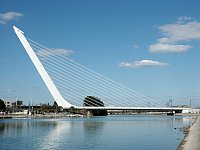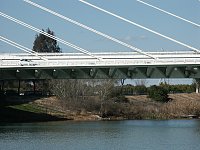
|
Sign at the base of the tall pylonIn 1992 Seville hosted the Expo (or World's Fair) on an island that had been largely undeveloped--La Cartuja Island. Four new bridges were built to the island, of which the Alamillo bridge is the by far largest and most impressive, becoming in the process a symbol for the city. The bridge spans the Meandro San Jeronimo River and was completed in just 31 months. |
| |
|
The asymmetric designA single pylon inclines away from the river and supports the 200 meter span with thirteen pairs of stay cables. As Alexander Tzonis explains," Rather than use back stays, Calatrava allowed the weight of the concrete-filled steel pylon to counterbalance the deck. By substituting one set of stay cables with the weight of the pylon inclined at 58 degrees, he created a new kind of cable-stayed bridge" (114). |

|
| |
|

|

|
The bridge form has been compared to a harp, ship's mast, and swan. |
| |
|

|

|

|
| |
|

|

|
|
| |
|
| "The spine serves as an elevated footpath, bisecting cantilevered traffic lanes 1.6 meters below" (Tzonis 114). Note the people walking across the spine and the cars crossing below. |

|

|


 Click here to return to index of art historical sites.
Click here to return to index of art historical sites.
 Click here to return to index of artists and architects.
Click here to return to index of artists and architects.
 Click here to return to chronological index.
Click here to return to chronological index.
 Click here to see the home page of Bluffton University.
Click here to see the home page of Bluffton University.
